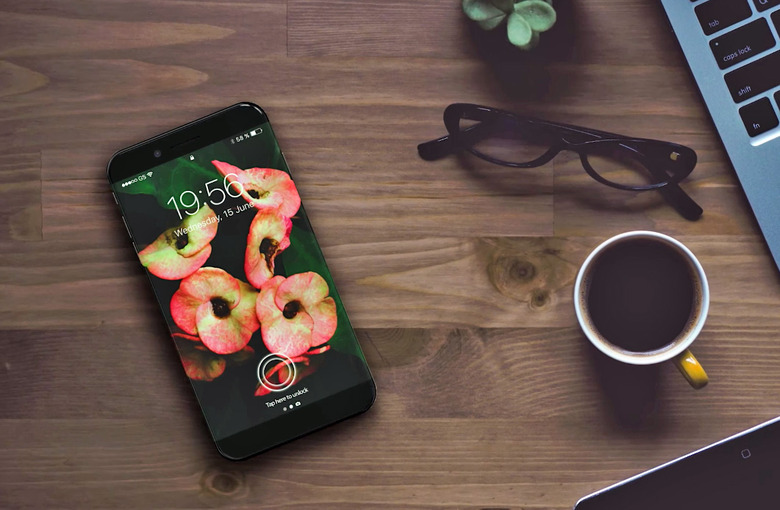WSJ Says iPhone 8 Will Have A Curved Display, But I'm Not Buying It
We're smack in the middle of the annual Mobile World Congress trade show in Barcelona, Spain, and we're almost exactly one month away from seeing Samsung unveil its next-generation Galaxy S8 and Galaxy S8+ flagship smartphones. So, needless to say, all attention has turned to Apple. The company is still nearly seven months away from taking the wraps off its next-generation iPhone 8 flagship phone, but the rumor mill is already heating up. Why? Because Apple's new tenth-anniversary iPhone is expected to be the first new Apple smartphone in three years to sport a bold new design and multiple exciting new features.
A new report published on Tuesday morning appears to confirm one of the biggest changes we expect to see in the upcoming new iPhone 8 later this year. But before you get too excited, let's turn back the clock a bit to make sure our feet stay planted firmly on the ground.
First, let's take a look at exactly what The Wall Street Journal reported on Tuesday morning.
"Apple Inc. has decided to adopt a flexible display for one model of the new iPhone coming out this year and has ordered sufficient components to enable mass production," Takashi Mochizuki said in his report.
He continued, "People with direct knowledge of Apple's production plans said the Cupertino, Calif., company has decided to go ahead with the technology, and it will release a phone model using the OLED screens this year."
That is the extent of the information Mochizuki was able to confirm with his unnamed sources. Then, he added a note about the capabilities of the display technology Apple will be adopting in its new iPhone. "The technology allows manufacturers to bend screens in ways they couldn't previously—such as by introducing a curve at the edge of the phone as in some Samsung models,"he wrote. "However, once the phone is manufactured, the OLED screen can't be bent or folded by the user, at least with current technology."
At no point do Mochizuki's sources state that the iPhone 8's display will actually be curved, at least not according to the report. He simply makes a leap from the iPhone 8 will include a flexible OLED display panel to the iPhone 8 will have a curved display. In fact, the article's headline empirically states: "Apple's Next iPhone Will Have a Curved Screen."
From this report and past rumors like it, industry watchers and Apple fans have connected the dots and begun to state that the iPhone 8 will feature a design similar to the one seen on various Samsung phones, like the Galaxy S7 edge and the Galaxy Note 7. These phones feature displays that curve down sharply on either side, creating a rounded design that fits nicely in the hand. I do not think Apple's iPhone 8 design will be anything like those Samsung phones.
First, in the case of the iPhone 8, there is absolutely no reason for the phone to have a display with steep curves on either side. According to a recent report from Ming-Chi Kuo, the most accurate Apple insider in the world, the iPhone 8 will feature a display that's similar in size to the iPhone 7 Plus screen, but it'll be stuffed into a phone that's about the same size as the smaller 4.7-inch iPhone 7. A phone with a footprint that small isn't like a monstrous Galaxy S7 edge or a Note 7. It doesn't need dramatically curved sides to fit comfortably in the hand. There's no other reason related to functionality to use a shape like this. So why would Apple release phone with that design?
Samsung is about to bring its curved edges to the smaller Galaxy S8, but for Samsung this is a signature design feature. And remember, Apple doesn't steal signature design features, other companies steal signature design features from Apple.
Here's what I think. The industry as a whole is moving toward flexible OLED display panels, and Apple will use these panels in its new iPhone. They offer better contrast, more vivid colors, deeper blacks, and better energy efficiency. Does that mean Apple necessarily plans to utilize the flexible properties of the panel to reshape it? Not necessarily.
If Apple does launch an iPhone 8 with a curved display, I would bet that the curves will be far more subtle than the iPhone people are imagining right now. Remember in 2014 when reports first emerged that Apple's upcoming new iPhone 6 would feature a curved glass face, and everyone took that little tidbit and ran with it? Then the new iPhone was released and we saw that the face was merely "2.5D" glass, featuring a subtle curve around the edges so that it fits more comfortably in the hand.
That, I would speculate, is where the truth lies. The OLED display on Apple's iPhone 8 is rumored to stretch from one side of the phone all the way to the other, with almost no bezels on either side. With that in mind, it's entirely possible that the sides of the screen will curve ever so slightly to follow the slope of the 2.5D glass (like the concept phone pictured at the top of this post). But if you believe Apple plans to ape Samsung's design and release a new iPhone with sides akin to what we've seen on its Galaxy S phones and on the Note 7, you've got another think coming.
